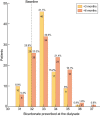Tailoring the dialysate bicarbonate eliminates pre-dialysis acidosis and post-dialysis alkalosis
- PMID: 36158145
- PMCID: PMC9494532
- DOI: 10.1093/ckj/sfac128
Tailoring the dialysate bicarbonate eliminates pre-dialysis acidosis and post-dialysis alkalosis
Abstract
Background: Both metabolic acidosis and alkalosis increase hospitalizations, haemodynamic instability and mortality in haemodialysis patients. Unfortunately, current practices opt for a one-size-fits-all approach, leaving many patients either acidotic before or alkalotic after dialysis sessions. Therefore an individualized adjustment of these patients' dialysate bicarbonate prescriptions could reduce these acid-base imbalances.
Methods: This is a prospective single-cohort study of patients on a chronic haemodiafiltration programme. The dialysate bicarbonate prescription was modified according to the pre- and post-dialysis total carbon dioxide (TCO2) values of 19-25 mEq/L and ≤29 mEq/L, respectively, with an adjustment formula calculated with the data obtained from previously published work by our group. In addition, we analysed this adjustment's effect on plasma sodium, potassium, phosphorus, parathyroid hormone (PTH) and calcium.
Results: At baseline, only 67.9% of patients were within the desired pre- and post-dialysis TCO2 target range. As of the first month, every followed patient met the TCO2 target range objective in pre-dialysis measurements and ˃95% met the post-dialysis TCO2 target. At the end of the study, 75% of the patients were on dialysate bicarbonate of 32-34 mEq/L. There were no clinically significant changes in calcium, phosphate, PTH, sodium or potassium levels. Also, we did not notice any increase in intradialytic adverse events.
Conclusions: We suggest an individualized adjustment of the dialysate bicarbonate concentration according to the pre- and post-dialysis TCO2 values. With it, nearly every patient in our cohort reached the established range, potentially reducing their mortality risk.
Keywords: acidosis; alkalosis; dialysate bicarbonate; haemodiafiltration; haemodialysis.
© The Author(s) 2022. Published by Oxford University Press on behalf of the ERA.
Figures
References
-
- Vallet M, Metzger M, Haymann JPet al. . Urinary ammonia and long-term outcomes in chronic kidney disease. Kidney Int 2015; 88: 137–145 - PubMed
LinkOut - more resources
Full Text Sources
Research Materials
Miscellaneous





